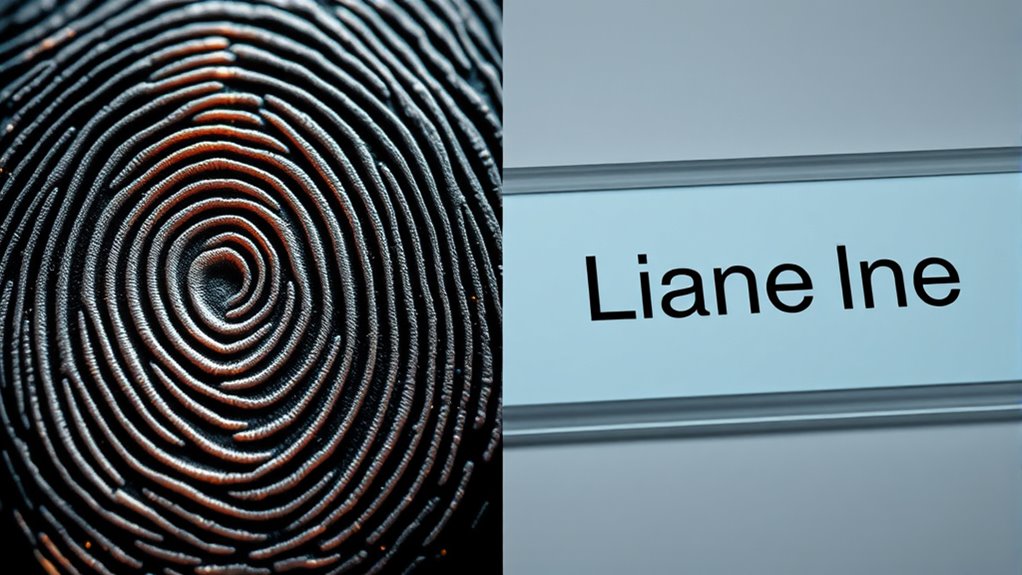Fingerprint checks are more accurate than name-based verification because they rely on unique biometric patterns that are nearly impossible to imitate. Name-based methods, on the other hand, depend on personal information that can be falsified or shared, making them less reliable. While fingerprint verification provides higher security, it also raises privacy concerns. If you want to understand the full differences and applications, you’ll find more insightful details if you keep exploring.
Key Takeaways
- Fingerprint checks are highly accurate due to biometric uniqueness, eliminating false positives common in name-based methods.
- Name-based verification relies on personal info that can be falsified, reducing overall accuracy.
- Combining fingerprint and name checks enhances reliability and minimizes impersonation risks.
- Fingerprint verification provides consistent, unchangeable biometric identifiers, unlike mutable personal data.
- Context and security needs influence accuracy; high-security environments favor biometric fingerprint checks.

When choosing between fingerprint and name-based checks, understanding their differences is crucial for ensuring accuracy and security. Fingerprint checks rely on biometric data, which involves analyzing unique patterns found in your fingerprints. This biometric reliability makes fingerprint verification highly accurate because no two fingerprints are alike. It’s difficult for someone to replicate or forge a fingerprint, which adds an extra layer of security. However, this method isn’t without its privacy concerns. Collecting and storing biometric data raises questions about how securely this sensitive information is protected and whether it could be misused. If biometric data falls into the wrong hands, the consequences could be severe, as unlike a password, you can’t reset your fingerprints. Additionally, hydrocolloid patches are known for promoting healing by drawing out impurities and can be an effective treatment for certain types of acne.
On the other hand, name-based checks are typically the simplest and most familiar method. They involve verifying an individual’s identity through personal information such as name, date of birth, or social security number. These checks are less invasive and don’t involve collecting physical or biometric data, reducing immediate privacy concerns. However, their biometric reliability is lower because names and personal details can be easily falsified, stolen, or shared. People often use pseudonyms or provide incorrect information, which can compromise the accuracy of name-based checks. This makes them more vulnerable to identity fraud or impersonation. In environments where security is critical, relying solely on name-based checks may not be enough, as they lack the robustness that biometric data offers.
When weighing these options, consider that fingerprint checks tend to be more reliable due to their biometric nature, but they come with heightened privacy concerns. You must trust that organizations handling biometric data follow strict security protocols to prevent breaches. Conversely, name-based checks are easier to implement and pose fewer privacy issues upfront but are often less dependable for high-security needs. In many cases, combining both methods provides a better balance—using biometric checks for accuracy and security, while maintaining privacy safeguards. Ultimately, your choice depends on the context: if security and accuracy are paramount, fingerprint checks might be the better option, provided privacy measures are in place. If privacy is your primary concern and the environment is less sensitive, name-based checks could suffice. Being aware of these trade-offs helps you make informed decisions aligned with your needs.
Frequently Asked Questions
How Do Environmental Factors Affect Fingerprint Accuracy?
Environmental factors can substantially impact fingerprint accuracy by causing sensor degradation or environmental interference. When your sensors are exposed to dirt, moisture, or extreme temperatures, they may produce poor-quality scans or false readings. These conditions hinder the sensor’s ability to capture clear fingerprint patterns, leading to errors. To maintain accuracy, you should regularly clean sensors and avoid using fingerprints in harsh environments, ensuring minimal environmental interference.
Can Name-Based Checks Detect Identity Theft?
Did you know that 85% of identity theft cases involve false or stolen identities? Name-based checks can help detect some fraudulent activities, but they’re less reliable for identity verification because names can be easily faked or stolen. For better data security, combining name-based checks with other methods offers stronger protection. Relying solely on names leaves gaps, so integrating multiple verification techniques is the best way to fight identity theft.
What Are the Legal Privacy Concerns With Fingerprint Data?
You should be aware that legal privacy concerns with fingerprint data center on maintaining legal compliance and ensuring data protection. When collecting and storing fingerprint information, you must follow laws like GDPR or CCPA, which require secure data handling and clear consent. Failing to protect this sensitive biometric data can lead to legal penalties, privacy breaches, and loss of user trust. Always prioritize robust security measures and transparent privacy policies.
How Do Biometric Errors Impact Security?
Biometric errors, like false rejection, can seriously impact security by allowing unauthorized access or denying legitimate users. Sensor calibration issues often cause these errors, making fingerprint scans unreliable. When sensors aren’t properly calibrated, they may misread fingerprints or reject valid ones, weakening security. To minimize risks, it’s essential to regularly calibrate sensors and implement multiple authentication methods, ensuring accurate identification and safeguarding sensitive information.
Are There Hybrid Methods Combining Both Checks?
You’re about to discover a game-changer in security—hybrid methods that combine biometric fusion with multi-factor authentication! These cutting-edge systems don’t just rely on a single check; they merge fingerprint scans, facial recognition, and more for near-perfect accuracy. This layered approach creates an impenetrable fortress, making unauthorized access impossible. With this combo, you get unparalleled security, transforming how you protect your data and identity in today’s digital world.
Conclusion
When choosing between fingerprint and name-based checks, remember that fingerprints act like a fingerprint in the ink of identity—unique and unchangeable. They paint a clearer picture, cutting through the fog of false matches. Names, like whispers in a crowded room, can be easily mistaken or manipulated. So, if you want accuracy that stands firm like a mountain’s shadow, rely on fingerprints. They’re your unerring lighthouse in the storm of identity verification.









